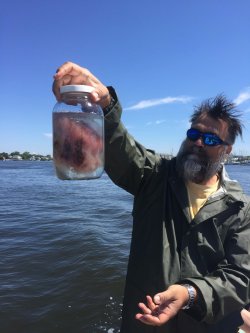
View Profile Page

Paul Bologna
Professor, Biology, College of Science and Mathematics
- Email:
- bolognap@montclair.edu
- Phone:
- 973-655-4112
- Degrees:
- BS, Michigan State University
- MS, University of Maine
- PhD, University of South Alabama
- vCard:
- Download vCard
Profile
Dr. Paul Bologna is a Professor of Biology and the Director of the Marine Biology and Coastal Sciences Program at Montclair State University. Dr. Bologna received a B.S. in Zoology from Michigan State University, a Masters Degree in Oceanography from the University of Maine, and a Ph.D. in Marine Science from the University of South Alabama. His research expertise lies within aquatic ecology with emphasis in two areas, Jellyfish Ecology and Seagrass Ecosystems. His current research includes understanding jellyfish communities in Barnegat Bay, coastal New Jersey and the US Virgin Islands. His research on seagrasses has spanned over two decades and includes research activities from the Caribbean, the Gulf of Mexico, the Mid-Atlantic, and Alaska. His research regarding seagrass restoration in New Jersey has demonstrated the efficacy of both physical transplant and seed related restoration techniques and earned him a 2002 Environmental Excellence Award from the New Jersey Department of Environmental Protection. Dr. Bologna has served in several capacities over the last 15 years as a board member in the New Jersey Academy of Science including serving as the president of the Academy from 2010 to 2013. While President, he was nominated to represent the Academy at the National level on the General Interest in Science and Engineering for the American Association for the Advancement of Science.
Specialization
Seagrass Ecosystems: New Jersey and in the U.S. Virgin Islands
Stinging Sea Nettles: Population Biology and Impacts on food webs in New Jersey
Invasive Jellyfish in New Jersey
Review of current projects and research interests can be found here.
https://www.researchgate.net/profile/Paul_Bologna
Resume/CV
Office Hours
Fall
- Tuesday
- 12:00 pm - 2:00 pm
- Thursday
- 12:00 pm - 2:00 pm
Links
Montclair State University does not endorse the views or opinions expressed in a faculty member's webpage or website. Consistent with the principles of academic freedom, the content provided is that of the author and does not express the opinions or views of Montclair State University.
Documents
Research Projects
Jellyfish Reduction in Coastal New Jersey
Barnegat Bay, New Jersey is a coastal lagoon system in the Mid-Atlantic region of the United States with significant urbanization and land use changes in its’ watershed. Chrysaora chesapeakei (Bay Nettle) have become established in the region over the last decade, and they have reshaped the pelagic food web becoming the dominant predator in the system (Bologna et al. 2017). Additionally, the increased numbers of adult medusae have led to reduced recreational use of the bay. After Super-Storm Sandy hit the New Jersey coast, a significant decline in sea nettles in Barnegat Bay was documented (Bologna et al 2018). Causality was based on knowing that any disruption during the polyp phase of life will subsequently lead to fewer polyps capable of producing ephyrae which grow into adult medusa. Simply put, the reduction of hard substrates (floating docks, bulkheads, etc.) in the bay most likely limited the size of polyp population. BTUSAR Squad 86, Save Barnegat Bay and Montclair State University have formed an information sharing coalition focused on achieving a cost-effective approach to polyp removal from man-made hard substrates.
We are assessing the feasibility and effectiveness of polyp removal from lagoon systems.
Assessment of clinging jellyfish Gonionemus vertens populations in the Shrewsbury River Estuary and the Manasquan River Estuary
The appearance of the invasive clinging jellyfish, Gonionemus vertens, in coastal New Jersey estuaries poses a potential conflict between the use of coastal estuaries and the safety of the general public using these waters. G. vertens is known to deliver substantial stings, which in some cases have resulted in hospitalization. This species is encountered in shallow water during the day where it clings to various substrates including seagrass and macroalgae. Its behavior involves swimming into the water column and drifting to the bottom feeding on organisms that it encounters. Because its distribution lies within shallow coastal embayments, there exists the potential of encounter with the public using these areas for recreation. The challenge we face with this invasive species is that nothing is known about the distribution and abundance of the adult medusa in New Jersey, nor the location of the polyp stage of their life history. This proposal looks to provide data to identify and quantify the distribution and abundance of G. vertens from the Shrewsbury Estuary and the Manasquan River Estuary.
Assessing Seagrass Restoration and Mitigation in New Jersey
Zostera marina (eelgrass) is one of the most widely distributed seagrasses in the world. It serves as essential fish habitat for many commercially and recreationally important species and provides stability to coastal systems through reductions in water velocity, increased wave attenuation, and stabilization of sediments. However, due to coastal eutrophication, Z. marina has undergone significant declines in spatial coverage throughout much of its range. Along the mid-Atlantic Coast, Z. marina declines have been linked to disease and changes in water quality and the problems facing many coastal managers relate to minimizing losses and increasing coverage through restoration efforts. In New Jersey, the wasting disease outbreak in the 1930’s is thought to be responsible for the elimination of Z. marina in the southern part of the state. Since limited natural transport of seeds can occur across these distances, active restoration may lead to significant increases in spatial coverage if successfully reestablished in these regions. Essentially, once small populations are established, they can expand vegetatively and through seed dispersal. This project will provide a critical assessment of the genetic structure of Z. marina populations in New Jersey and proved guidance for future restorations efforts.